The forecasts for the domestic economy are underpinned by several technical assumptions. The exchange rate is assumed to remain around levels at the time the forecasts were prepared (a trade‑weighted index of around 71 and a $US exchange rate of around 92c). Interest rates are assumed to rise in line with market expectations over the forecast period, that is, a rise in the cash rate to about 5 per cent by early 2011. World oil prices (Tapis) are assumed to remain at around $US84 per barrel. The farm sector forecasts are based on average seasonal conditions over the remainder of the forecasting period.
Household consumption
The outlook for household consumption has strengthened since December JEFG. Consumer confidence has been bolstered by improved employment outcomes and the rebound in household wealth from rising house prices and share values. In the second half of 2009, retail trade continued to grow solidly.
Household consumption grew by a solid 0.7 per cent in both the September and December quarters. The unwinding of the stimulus and rising interest rates do not appear to have substantially weakened household consumption.
The forecast for household consumption growth in 2009‑10 has been revised up from 1¾ per cent at December JEFG to 3 per cent. Household consumption is expected to grow by 3½ per cent in 2010‑11 and 4 per cent in 2011‑12, supported by a pick‑up in wages growth (Chart 1).
Chart 1: Household Consumption
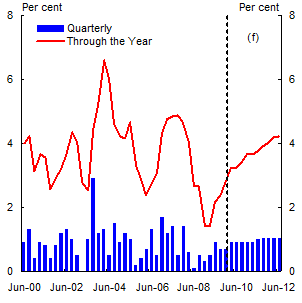
Source: ABS Catalogue Number 5206.0 and Treasury.
The household saving ratio is expected to decline over the forecast period but remain positive (Chart 2). A recovery in asset values is expected to see some reduction in the rate of saving out of current income.
Chart 2: Household Savings Ratio
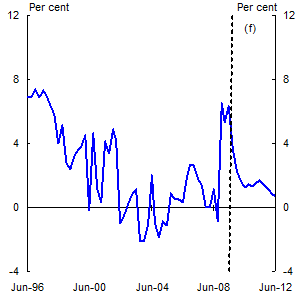
Source: ABS Catalogue Number 5206.0 and Treasury.
Dwelling investment
A recovery in dwelling investment is expected over the forecast horizon. Recent commencements and approvals data indicate continued strength in the pipeline that will support activity over most of 2010. Dwelling unit commencements grew strongly during the second half of 2009 while approvals are currently running at levels last seen in late 2007. Detached houses will continue to lead the recovery with private house approvals rising in 12 out of the last 13 months.
While the First Home Owners Boost was phased out at the end of 2009, house price growth, improved household confidence, strong population growth and a more promising employment outlook are expected to attract upgraders and investors back into the market.
Business liaison suggests that credit conditions for medium and high‑density developments have improved somewhat. However, continuing difficulties in accessing finance, particularly for small developers, along with interest rates rising to more normal levels are expected to temper the momentum in dwelling investment. Dwelling investment is forecast to grow by 8½ per cent in 2010‑11, down from 11 per cent at December JEFG, and increase by 4 per cent in 2011‑12.
Chart 3: Private Dwelling investment (real)
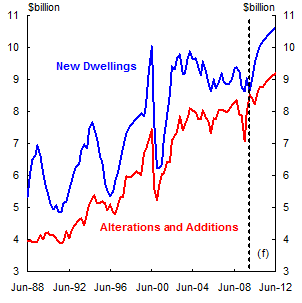
Source: ABS Catalogue Number. 5206.0 and Treasury.
Business investment
New business investment is now expected to fall only modestly in 2009‑10 by 2½ per cent, before recovering strongly, growing by 6 per cent in 2010‑11 and 12 per cent in 2011‑12. The recovery is expected to be driven by a pick‑up in underlying investment and a renewed surge in mining investment.
Forecasts for 2009‑10 have increased from December JEFG due to the significant boost to investment in new machinery and equipment from the Small Business and General Business Tax Break in late 2009 and a modest improvement in underlying conditions. The improvement in underlying conditions is expected to gather momentum through 2010‑11 and 2011‑12. Non‑residential building investment is expected to remain subdued until late in the forecast period (Chart 4).
Chart 4: Business Investment to GDP ratio (nominal)
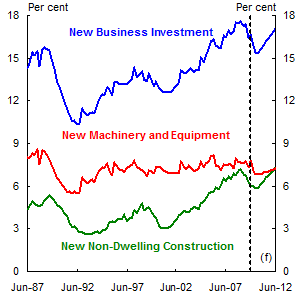
Source: ABS Catalogue Number 5206.0 and Treasury.
Survey measures of business conditions and business confidence have generally been tracking above long‑run average levels since late 2009, with confidence currently at its highest level since 2002.
Forecast investment in new machinery and equipment is stronger than at December JEFG, reflecting higher CAPEX intentions in the December quarter release and a stronger economy. Investment is now expected to fall slightly by ½ of a per cent in 2009‑10. While stimulus‑related investment incentives have now been withdrawn, investment in machinery and equipment is forecast to rise over the forecast horizon as firms resume necessary maintenance and asset replacement programs that were previously delayed. This is expected to drive growth of 6 per cent in 2010‑11 and 13 per cent in 2011‑12.
New engineering construction investment is expected to grow strongly over the forecast horizon as a number of major resource projects commence and begin to ramp up. Recent CAPEX data indicate particular strength in investment intentions for 2010‑11 in the mining sector which appears likely to be repeated in 2011‑12. Engineering investment is expected to increase by 4 per cent in 2009‑10, followed by growth of 19 per cent in 2010‑11 and 20½ per cent in 2011‑12. A major driver of the forecasts is the significant number of large scale LNG projects currently under construction or approaching final investment decisions.
New non‑residential building investment is expected to fall by 7 per cent in 2009‑10, before a modest recovery commences in 2010‑11 with growth of 8 per cent followed by growth of 14 per cent in 2011‑12. The short‑term outlook for the sector remains subdued with continuing weak levels of building approvals, rising vacancy rates and credit constraints. However, as commercial property vacancy rates stabilise and previously built floor space is absorbed through the broader recovery of the economy, building approvals are expected to recover during 2011, leading to renewed activity in the sector.
Public final demand
New public final demand is forecast to grow by 7¼ per cent in 2009‑10, 1 per cent in 2010‑11 and to fall by ½ of a per cent in 2011‑12. These growth profiles are driven by Government stimulus measures and their subsequent withdrawal. The forecast for 2011‑12 also takes into account the Commonwealth's fiscal targets.
The withdrawal of the Government's fiscal stimulus has already begun. The peak impact of the stimulus on GDP growth is estimated to have occurred in the June quarter 2009 and has since been phasing down. Through the year to the December quarter 2010, the withdrawal of stimulus is expected to detract around 1 percentage point from GDP growth. The bulk of the stimu
lus that remains is in building infrastructure.
Exports, imports and the current account deficit
While export volumes are expected to grow strongly over the forecast period in line with a forecast rebound in global growth, import volumes are forecast to increase at a more rapid pace — reflecting strengthening domestic activity and a high exchange rate.
As such, net exports are expected to detract 1 percentage point from GDP growth in both 2009‑10 and 2010‑11, and ¾ of a percentage point in 2011‑12.
Export volumes are forecast to grow modestly in 2009‑10, followed by stronger growth of 5 per cent in 2010‑11 and 5½ per cent in 2011‑12.
Chart 5: Net Exports — contribution to GDP growth
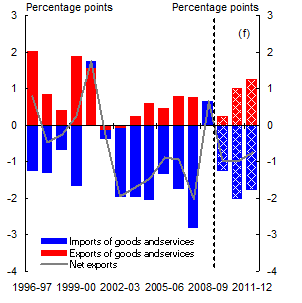
Source: ABS Catalogue Number. 5206.0 and Treasury.
Non‑rural commodity exports are expected to increase significantly over the forecast period, reflecting strengthening global demand and additional supply capacity. Demand for Australia's bulk commodity exports is expected to increase, driven by ongoing strong demand from China and a rebound in steel production in the rest of the world. Australian iron ore mine capacity is expected to increase over the forecast period, and coal exports will be boosted by further port expansions on the east coast.
As such, exports of non‑rural commodities are expected to grow by 4 per cent in 2009‑10 — a sizeable increase compared with December JEFG — followed by growth of 7½ per cent for both 2010‑11 and 2011‑12.
Farm production is expected to grow by 6 per cent in 2009‑10. This represents a significant improvement on the December JEFG forecasts, as better‑than‑expected rainfall in key growing areas is expected to improve yields. Farm production is expected to remain at a high level over the remainder of the forecast period.
Chart 6: Non‑rural Commodities
(Volumes)
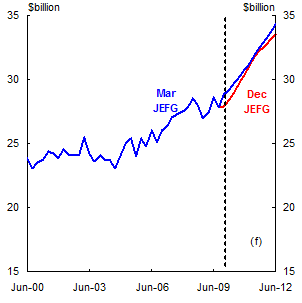
Source: ABS Catalogue Number 5206.0 and Treasury.
The stronger outlook for world growth has improved the prospects for exports of elaborately transformed manufactures (ETM) and services. ETM exports are expected to grow by 4 per cent in 2010‑11 and 4½ per cent in 2011‑12, stronger than expected at December JEFG. This reflects a more positive outlook for exports of transport equipment, in line with the forecast recovery in key export markets. Services exports are expected to fall by 2 per cent in 2009‑10 following a sustained decline in foreign student commencements in Australia's education sector, particularly from South Asia. Services exports are expected to grow by 1½ per cent in 2010‑11 and 6 per cent in 2011‑12, as the world economy recovers.
The outlook for imports growth is slightly stronger than at December JEFG, in line with stronger domestic demand. Import volumes are forecast to increase by 6 per cent in 2009‑10, 9 per cent in 2010‑11 and 8 per cent in 2011‑12. Strong growth in the latter part of the forecast period reflects an expected pickup in imported capital equipment for use in the construction of large LNG projects.
Following a forecast fall of 5 per cent in 2009‑10, the terms of trade are forecast to increase by 10½ per cent in 2010‑11. This largely reflects expectations of significant contract price rises for coal and iron ore in 2010, due to increasing world demand. New metallurgical coal contract prices have recently been settled by BHP Billiton, with reports suggesting a US$ price of around 55 per cent above the JFY2009‑10 level. For 2011‑12, the terms of trade are forecast to be flat — with commodity prices expected to remain at a high level. Import prices are forecast to remain at a low level over the forecast period, following the significant appreciation of the Australian dollar and global excess capacity.
Chart 7: Terms of Trade
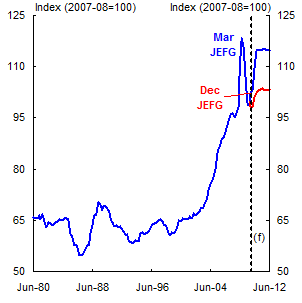
Source: ABS Catalogue Number 5206.0 and Treasury.
The trade deficit is expected to narrow significantly in 2010‑11 to be ¼ of a per cent of GDP. This largely reflects higher non‑rural commodity export prices. The trade deficit is forecast to widen slightly to ½ of a per cent of GDP in 2011‑12 due to higher import volumes.
The net income deficit is expected to widen significantly in 2010‑11, to 4¼ per cent of GDP — wider than at December JEFG. This largely reflects the expectation of increased income outflows, in line with the stronger forecast for non‑rural commodity export income.
The current account deficit (CAD) is forecast to widen to 5 per cent of GDP in 2009‑10 — less of a widening than at December JEFG, reflecting the stronger terms of trade. The CAD is expected to narrow to 4¼ per cent of GDP in 2010‑11 due to higher export earnings, before widening to 5 per cent of GDP in 2011‑12.
Chart 8: Current Account Deficit
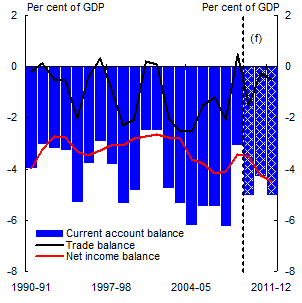
Source: ABS Catalogue Numbers 5206.0, 5302.0 and Treasury.
Employment, wages and inflation
The employment outlook has improved since December JEFG, reflecting continued momentum in recent labour market outcomes and a stronger outlook for the economy. Spare capacity in the labour market appears to be diminishing.
The labour market has performed better than expected in recent months, with almost 200,000 jobs created in the past six months and the unemployment rate declining in three of the past four months. Employment is expected to grow by 2½ per cent through the year to the June quarter 2010, much stronger than the 1 per cent expected at December JEFG.
Hours worked have also been increasing, with trend aggregate hours rising for eight consecutive months. Average hours are now at their highest level in 12 months. Average hours are expected to improve further over the forecast period.
A more positive outlook for employment is expected to result in a lower unemployment rate over the forecast period than expected at December JEFG. The unemployment rate is expected to fall to 5 per cent by June quarter 2011, in line with an expectation that the labour market will reach full capacity in that period.
Chart 9: Employment Growth and Total Hours (sa)
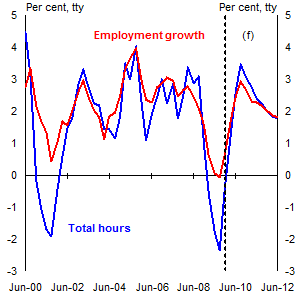
Source: ABS Catalogue Number 6202.0 and Treasury.
The participation rate has declined only modestly during the downturn, and is expected to trend up slowly over the forecast period, to reach 65½ per cent in the June quarter 2011. The increasing participation rate over the forecast period also takes account of underlying demographic trends, with the forecasts assuming a continuation of the increases in age‑ and gender‑specific participation rates that have been experienced in
recent years.
The overall outlook for wages has been revised up since December JEFG, consistent with a tightening labour market and a recovering economy. However, historically low wage growth in the December quarter means that annual wages growth is likely to be weak in the near term.
The National Accounts measure of Average Weekly Earnings recorded its slowest through‑the‑year growth on record in the December quarter. The recovery in average hours worked and full‑time employment over the next few quarters is likely to contribute to earnings growth over the next year.
Chart 10: Unemployment and Participation Rates (sa)'
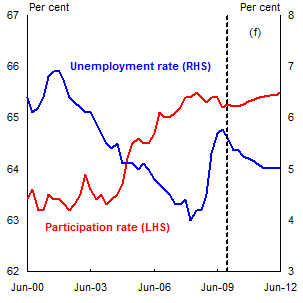
Source: ABS Catalogue Number 6202.0 and Treasury.
A weak December quarter result, continued downward pressure from the 2009 Australian Fair Pay Commission's minimum wage decision and ongoing weakness in outcomes for wage agreements suggest that annual growth in the Wage Price Index (WPI) will continue to be weak for most of 2010. The current strength of the labour market is expected to result in faster wages growth towards the end of 2010 and in early 2011. Beyond this, with the labour market rapidly approaching capacity and with ongoing impetus from the recovery in the terms‑of‑trade, wages are expected to grow above trend going into 2012. The WPI is expected to grow by 2¾ per cent through the year to the June quarter 2010 rising to 4 per cent through the year to the June quarter 2012.
The forecasts for headline and underlying inflation have been upgraded since December JEFG. Underlying inflation is expected to continue to ease over the coming quarters, reflecting recent falls in import prices, moderate wages growth and a considerable easing in the demand pressures that prevailed in 2008. Underlying inflation is expected to be 2¾ per cent through the year to the June quarter 2010 and 2½ per cent through the year to the June quarters of both 2011 and 2012.
Headline inflation is expected to pick up in the near term as automotive fuel and financial services prices rebound after exhibiting large falls in 2009. Headline inflation is expected to be 3 per cent through the year to the June quarter 2010 before moderating to 2½ per cent through the year to the June quarter 2011 and picking up to 3 per cent through the year to the June quarter 2012.
Chart 11: Headline and Underlying Inflation
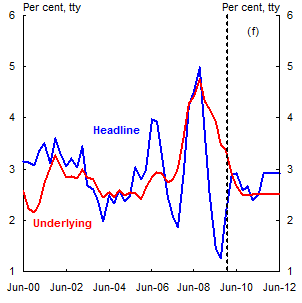
Note: Excludes the effects of the new tax system.
Source: ABS Cataloge Number 6401.0, RBA and Treasury.
The forecasts for headline inflation incorporate the proposed commencement of the Carbon Pollution Reduction Scheme (CPRS) on 1 July 2011. The CPRS is expected to increase headline inflation over 2011‑12 by 0.4 per cent, with most of the impact occurring in the September quarter 2011. It has been assumed that the CPRS will have no impact on underlying inflation.